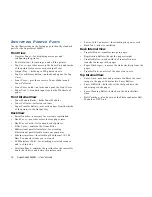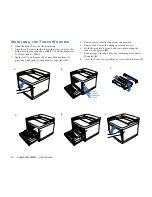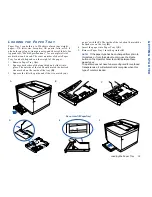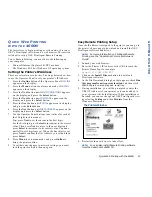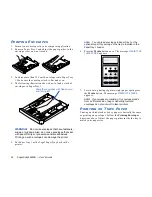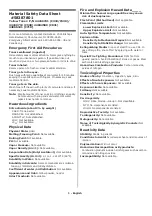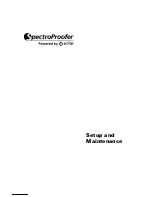
Printing Transparencies
25
GETTING STARTED
P
RINTING
T
RANSPARENCIES
•
Create the information you need printed on the
transparencies within your application. Try printing on a
plain sheet of paper first for proper placement.
•
Print transparencies from Paper Tray 1 only.
•
Load up to 50 sheets in Paper Tray 1.
•
Keep the paper path clean. Transparencies are especially
sensitive to dirt. If shadows appear on either the top or
bottom of the sheets, refer to Chapter 8, “Maintaining
Your Printer,” for instructions on how to clean the
printer.
•
If the manufacturer put a removable strip at the edge of
the transparencies, load the transparencies with the strip
toward the front of the printer (even if they recommend
that the striped edge faces the back of the printer).
•
The printer will automatically detect transparencies in
Paper Tray 1.
•
The best quality printing will be inside a 10 mm border
around the edge of the transparency
note:
The terms OHT (found on Operator Panel) and
OHP (found inside Paper Tray 1) both refer to
transparencies.
•
The OHT light on the Operator Panel will start blinking
when the printer detects transparencies in Paper Tray 1.
P
RINTING
L
ABELS
Print labels as you would thick paper. Printing labels,
envelopes, thick paper, or transparencies takes slightly longer
than plain paper.
Be careful to fan and align the label sheets in Paper Tray 1.
When adding more label sheets, remove the ones already in
the tray. Stack and fan together before putting them back.
1.
Remove Paper Tray 1 and load no more than 80 label
sheets.
2.
Reinsert Paper Tray 1 into the feeder.
note:
You can load label sheets in Paper Tray 1 or the
optional Legal Tray as long as the tray is inserted in the
Paper Tray 1 feeder.
3.
Press the Media button once. The message
MEDIA TYPE
THICK
STOCK
appears.
4.
To return to printing regular weight paper, press the
Media
button. The message
MEDIA TYPE PAPER
appears.
note:
Load label sheets face up in the tray.
10mm
Best Print Area




